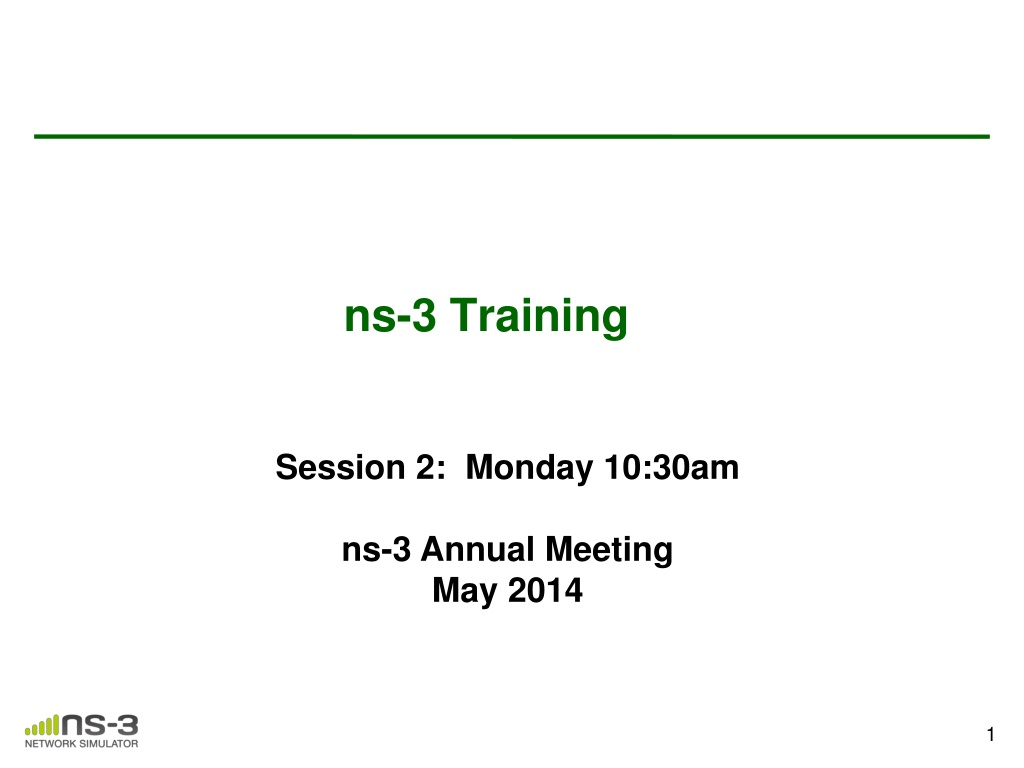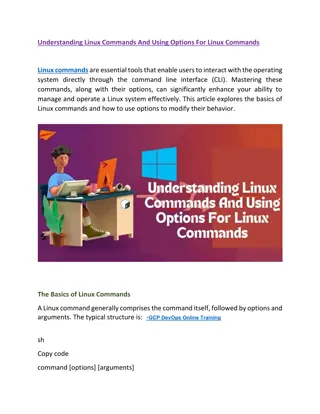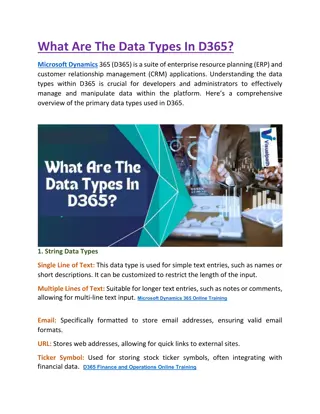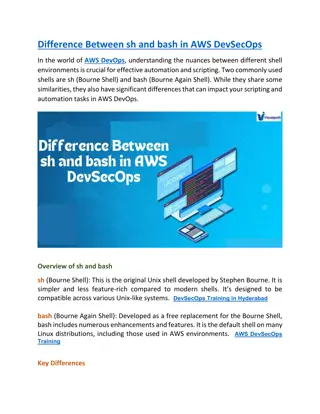NS-3 Simulation Basics and Software Orientation
Delve into the fundamentals of NS-3 simulation, including discrete-event simulation basics, software orientation, simulator examples, program flow, command-line arguments, time management, and event handling. Explore how NS-3 sets itself apart through its C++ and Python scriptability, command-line interface, and event-driven architecture.
Download Presentation

Please find below an Image/Link to download the presentation.
The content on the website is provided AS IS for your information and personal use only. It may not be sold, licensed, or shared on other websites without obtaining consent from the author.If you encounter any issues during the download, it is possible that the publisher has removed the file from their server.
You are allowed to download the files provided on this website for personal or commercial use, subject to the condition that they are used lawfully. All files are the property of their respective owners.
The content on the website is provided AS IS for your information and personal use only. It may not be sold, licensed, or shared on other websites without obtaining consent from the author.
E N D
Presentation Transcript
ns-3 Training Session 2: Monday 10:30am ns-3 Annual Meeting May 2014 1
Discrete-event simulation basics Simulation time moves in discrete jumps from event to event C++ functions schedule events to occur at specific simulation times A simulation scheduler orders the event execution Simulation::Run() gets it all started Simulation stops at specific time or when events end 2 NS-3 Annual Meeting May 2014
Software orientation Key differences from other tools: 1) Command-line, Unix orientation vs. Integrated Development Environment (IDE) 2) Simulations and models written directly in C++ and Python vs. a domain-specific simulation language NS-3 Annual Meeting May 2014
Simulator example 4 NS-3 Annual Meeting May 2014
Simulator example (in Python) 5 NS-3 Annual Meeting May 2014
Simulation program flow Handle program inputs Configure topology Run simulation Process outputs NS-3 Annual Meeting May 2014
Command-line arguments Add CommandLine to your program if you want command-line argument parsing Passing --PrintHelp to programs will display command line options, if CommandLine is enabled ./waf --run "sample-simulator --PrintHelp" 7 NS-3 Annual Meeting May 2014
Time in ns-3 Time is stored as a large integer in ns-3 Minimize floating point discrepancies across platforms Special Time classes are provided to manipulate time (such as standard operators) Default time resolution is nanoseconds, but can be set to other resolutions Time objects can be set by floating-point values and can export floating-point values double timeDouble = t.GetSeconds(); 8 NS-3 Annual Meeting May 2014
Events in ns-3 Events are just function calls that execute at a simulated time i.e. callbacks another difference compared to other simulators, which often use special "event handlers" in each model Events have IDs to allow them to be cancelled or to test their status 9 NS-3 Annual Meeting May 2014
Simulator and Schedulers The Simulator class holds a scheduler, and provides the API to schedule events, start, stop, and cleanup memory Several scheduler data structures (calendar, heap, list, map) are possible A "RealTime" simulation implementation is possible aligns the simulation time to wall-clock time 10 NS-3 Annual Meeting May 2014
from src/core/examples/sample-rng-plot.py Random Variables Currently implemented distributions Uniform: values uniformly distributed in an interval Constant: value is always the same (not really random) Sequential: return a sequential list of predefined values Exponential: exponential distribution (poisson process) Normal (gaussian), Log-Normal, Pareto, Weibull, triangular 11 NS-3 Annual Meeting May 2014
Random variables and independent replications Many simulation uses involve running a number of independent replications of the same scenario In ns-3, this is typically performed by incrementing the simulation run number not by changing seeds 12 NS-3 Annual Meeting May 2014
ns-3 random number generator Uses the MRG32k3a generator from Pierre L'Ecuyer http://www.iro.umontreal.ca/~lecuyer/myftp/papers/str eams00.pdf Period of PRNG is 3.1x10^57 Partitions a pseudo-random number generator into uncorrelated streams and substreams Each RandomVariableStream gets its own stream This stream partitioned into substreams 13 NS-3 Annual Meeting May 2014
Run number vs. seed If you increment the seed of the PRNG, the streams of random variable objects across different runs are not guaranteed to be uncorrelated If you fix the seed, but increment the run number, you will get an uncorrelated substream 14 NS-3 Annual Meeting May 2014
Putting it together Example of scheduled event Demo real-time, command-line, random variables... 15 NS-3 Annual Meeting May 2014
The basic model Application Application Application Application Sockets-like API Protocol stack Protocol stack Packet(s) Node Node NetDevice NetDevice NetDevice NetDevice Channel Channel 17 ns-3
Example program examples/wireless/wifi-simple-adhoc- grid.cc examine wscript for necessary modules 'internet', 'mobility', 'wifi', 'config-store', 'tools' we'll add 'visualizer' ./waf configure --enable-examples -- enable-modules=... 18 NS-3 Annual Meeting May 2014
Example program (5x5) grid of WiFi ad hoc nodes OLSR packet routing Try to send packet from one node to another Source (node 24) by default WiFi Goal is to read and understand the high-level ns-3 API Sink (node 0) by default 19 NS-3 Annual Meeting May 2014
Fundamentals Key objects in the simulator are Nodes, Packets, and Channels Nodes contain Applications, stacks , and NetDevices 20 ns-3
Node basics A Node is a shell of a computer to which applications, stacks, and NICs are added Application Application Application DTN 21 ns-3
NetDevices and Channels NetDevices are strongly bound to Channels of a matching type WifiChannel WifiNetDevice Nodes are architected for multiple interfaces 22 ns-3
Internet Stack Internet Stack Provides IPv4 and some IPv6 models currently No non-IP stacks in ns-3.19 but no dependency on IP in the devices, Node, Packet, etc. IEEE 802.15.4-based models introduced for ns-3.20 23 ns-3
Other basic models in ns-3 Devices WiFi, WiMAX, CSMA, Point-to-point, Bridge Error models and queues Applications echo servers, traffic generator Mobility models Packet routing OLSR, AODV, DSR, DSDV, Static, Nix- Vector, Global (link state) 24 ns-3
ns-3 Packet Packet is an advanced data structure with the following capabilities Supports fragmentation and reassembly Supports real or virtual application data Extensible Serializable (for emulation) Supports pretty-printing Efficient (copy-on-write semantics) 25 ns-3
ns-3 Packet structure Analogous to an mbuf/skbuff 26 ns-3
Copy-on-write Copy data bytes only as needed Figure source: Mathieu Lacage's Ph.D. thesis 27 ns-3
Structure of an ns-3 program int main (int argc, char *argv[]) { // Set default attribute values // Parse command-line arguments // Configure the topology; nodes, channels, devices, mobility // Add (Internet) stack to nodes // Configure IP addressing and routing // Add and configure applications // Configure tracing // Run simulation } 28 ns-3
Review of example program 29 ns-3
Helper API The ns-3 helper API provides a set of classes and methods that make common operations easier than using the low-level API Consists of: container objects helper classes The helper API is implemented using the low- level API Users are encouraged to contribute or propose improvements to the ns-3 helper API 30 ns-3
Containers Containers are part of the ns-3 helper API Containers group similar objects, for convenience They are often implemented using C++ std containers Container objects also are intended to provide more basic (typical) API 31 ns-3
The Helper API (vs. low-level API) Is not generic Does not try to allow code reuse Provides simple 'syntactical sugar' to make simulation scripts look nicer and easier to read for network researchers Each function applies a single operation on a ''set of same objects A typical operation is "Install()" 32 ns-3
Helper Objects NodeContainer: vector of Ptr<Node> NetDeviceContainer: vector of Ptr<NetDevice> InternetStackHelper WifiHelper MobilityHelper OlsrHelper ... Each model provides a helper class 33 ns-3
Example program (5x5) grid of WiFi ad hoc nodes OLSR packet routing Try to send packet from one node to another Source (node 24) by default WiFi Let s look closely at how these objects are created Sink (node 0) by default 34 NS-3 Annual Meeting May 2014
Installation onto containers Installing models into containers, and handling containers, is a key API theme NodeContainer c; c.Create (numNodes); ... mobility.Install (c); ... internet.Install (c); ... 35 NS-3 Annual Meeting May 2014
Mobility models in ns-3 The MobilityModel interface: void SetPosition (Vector pos) Vector GetPosition () StaticMobilityModel Node is at a fixed location; does not move on its own RandomWaypointMobilityModel (works inside a rectangular bounded area) Node pauses for a certain random time Node selects a random waypoint and speed Node starts walking towards the waypoint When waypoint is reached, goto first state RandomDirectionMobilityModel works inside a rectangular bounded area) Node selects a random direction and speed Node walks in that direction until the edge Node pauses for random time Repeat y z x 3D Cartesian coordinate system 36 ns-3
Internet stack The public interface of the Internet stack is defined (abstract base classes) in src/network/model directory The intent is to support multiple implementations The default ns-3 Internet stack is implemented in src/internet-stack 37 ns-3
ns-3 TCP Several options exist: native ns-3 TCP Tahoe, Reno, NewReno (others in development) TCP simulation cradle (NSC) Use of virtual machines or DCE (more on this later) To enable NSC: internetStack.SetNscStack ("liblinux2.6.26.so"); 38 ns-3
ns-3 simulation cradle Port by Florian Westphal of Sam Jansen s Ph.D. work Figure reference: S. Jansen, Performance, validation and testing with the Network Simulation Cradle. MASCOTS 2006. 39 ns-3
ns-3 simulation cradle For ns-3: Linux 2.6.18 Linux 2.6.26 Linux 2.6.28 Others: FreeBSD 5 lwip 1.3 OpenBSD 3 Other simulators: ns-2 OmNET++ Figure reference: S. Jansen, Performance, validation and testing with the Network Simulation Cradle. MASCOTS 2006. 40 ns-3
IPv4 address configuration An Ipv4 address helper can assign addresses to devices in a NetDevice container Ipv4AddressHelper ipv4; ipv4.SetBase ("10.1.1.0", "255.255.255.0"); csmaInterfaces = ipv4.Assign (csmaDevices); ... ipv4.NewNetwork (); // bumps network to 10.1.2.0 otherCsmaInterfaces = ipv4.Assign (otherCsmaDevices); 41 ns-3
Applications and sockets In general, applications in ns-3 derive from the ns3::Application base class A list of applications is stored in the ns3::Node Applications are like processes Applications make use of a sockets-like API Application::Start () may call ns3::Socket::SendMsg() at a lower layer 42 ns-3
Sockets API Plain C sockets ns-3 sockets int sk; sk = socket(PF_INET, SOCK_DGRAM, 0); Ptr<Socket> sk = udpFactory->CreateSocket (); struct sockaddr_in src; inet_pton(AF_INET, 0.0.0.0 ,&src.sin_ad dr); src.sin_port = htons(80); bind(sk, (struct sockaddr *) &src, sizeof(src)); sk->Bind (InetSocketAddress (80)); struct sockaddr_in dest; inet_pton(AF_INET, 10.0.0.1 ,&dest.sin_ addr); dest.sin_port = htons(80); sendto(sk, hello , 6, 0, (struct sockaddr *) &dest, sizeof(dest)); sk->SendTo (InetSocketAddress (Ipv4Address ( 10.0.0.1 ), 80), Create<Packet> ( hello , 6)); char buf[6]; recv(sk, buf, 6, 0); } sk->SetReceiveCallback (MakeCallback (MySocketReceive)); [ ] (Simulator::Run ()) void MySocketReceive (Ptr<Socket> sk, Ptr<Packet> packet) { ... } 43 ns-3
Attributes and default values 44 NS-3 Annual Meeting May 2014
ns-3 attribute system Problem: Researchers want to identify all of the values affecting the results of their simulations and configure them easily ns-3 solution: Each ns-3 object has a set of attributes: A name, help text A type An initial value Control all simulation parameters for static objects Dump and read them all in configuration files Visualize them in a GUI Makes it easy to verify the parameters of a simulation 45 ns-3
Short digression: Object metadata system ns-3 is, at heart, a C++ object system ns-3 objects that inherit from base class ns3::Object get several additional features dynamic run-time object aggregation an attribute system smart-pointer memory management (Class Ptr) We focus here on the attribute system 46 ns-3
Use cases for attributes An Attribute represents a value in our system An Attribute can be connected to an underlying variable or function e.g. TcpSocket::m_cwnd; or a trace source 47 ns-3
Use cases for attributes (cont.) What would users like to do? Know what are all the attributes that affect the simulation at run time Set a default initial value for a variable Set or get the current value of a variable Initialize the value of a variable when a constructor is called The attribute system is a unified way of handling these functions 48 ns-3
How to handle attributes The traditional C++ way: export attributes as part of a class's public API walk pointer chains (and iterators, when needed) to find what you need use static variables for defaults The attribute system provides a more convenient API to the user to do these things 49 ns-3
Navigating the attributes Attributes are exported into a string-based namespace, with filesystem-like paths namespace supports regular expressions Attributes also can be used without the paths e.g. ns3::WifiPhy::TxGain A Config class allows users to manipulate the attributes 50 ns-3























